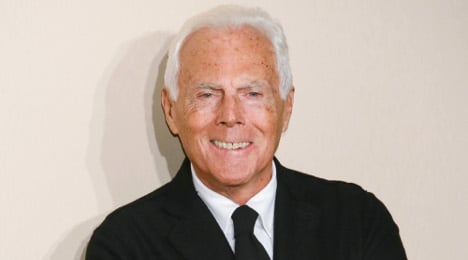Michele Ferrero and his kin are the richest family in Italy, with a $26.5 billion (€19.25 billion) fortune built on sugary products including Nutella, Kinder and Ferrero Rocher chocolates, according to the list published on Tuesday.
They are followed Leonardo Del Vecchio, who in 38th place is Italy’s wealthiest fashion mogul with assets worth $19.2 billion.
While Luxottica, the company Del Vecchio founded in 1961, may not be a household name, his sunglasses certainly are. Del Vecchio’s shades are sold the world over, including Oakley and Ray-Ban, while Luxottica also produces sunglasses for nearly every fashion house going, from Burberry to Versace.
Designers Miuccia Prada and Giorgio Armani, who came 102nd and 129th in the ranking respectively, are also further proof that style pays.
Working in the family fashion business has proved lucrative for Prada, who is worth $11.1 billion, while Armani boasts a $9.9 billion fortune.
Having founded his fashion house in 1975, Armani has since expanded his empire and has a 4.9 percent stake in Del Vecchio’s Luxottica. According to Forbes, he is also the proud owner of a $50-million yacht and ten houses.
Prada’s husband Patrizio Bertelli also makes an appearance on the billionaires’ list: with $6 billion to his name, he is the world’s 234th richest person.
While luxury goods continue to bankroll the richest Italians, both the Ferrero family and a second sweet-toothed billionaire prove that cheap products can be profitable. Augusto and Giorgio Perfetti share $7.2 billion between them, ranking 186th, owing to their family’s Perfetti Van Melle business built on the sale of chewing gum.
Also making an appearance is Stefano Pessina, described by Forbes as a Monaco resident who turned his family’s pharmaceutical company around, which has since merged to form Alliance Boots, netting $10.4 billion in the process.
The only Italian industrialists to make it into the top 500 are Paolo and Gianfelice Mario Rocca, who made their shared $6.3 billion fortune after their grandfather founded the Argentine-Italian steel company Techint Group.
Despite enduring a fairly dire 2013 with a string of court cases and being thrown out of Italian parliament, Silvio Berlusconi can at least retain his title as one of the world’s wealthiest.
The former prime minister and his family have $9 billion to their name, spread out across numerous business interests including broadcaster Mediaset and AC Milan football club.
The “poorest” of the Italian billionaires is Rosa Anna Magno Garavoglia, with a meagre $3.5 billion owing to the Italian drinks company Campari.
Don't miss a story about Italy – Join us on Facebook and Twitter.



 Please whitelist us to continue reading.
Please whitelist us to continue reading.
Member comments